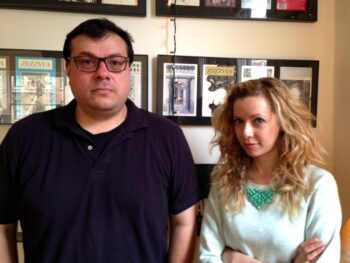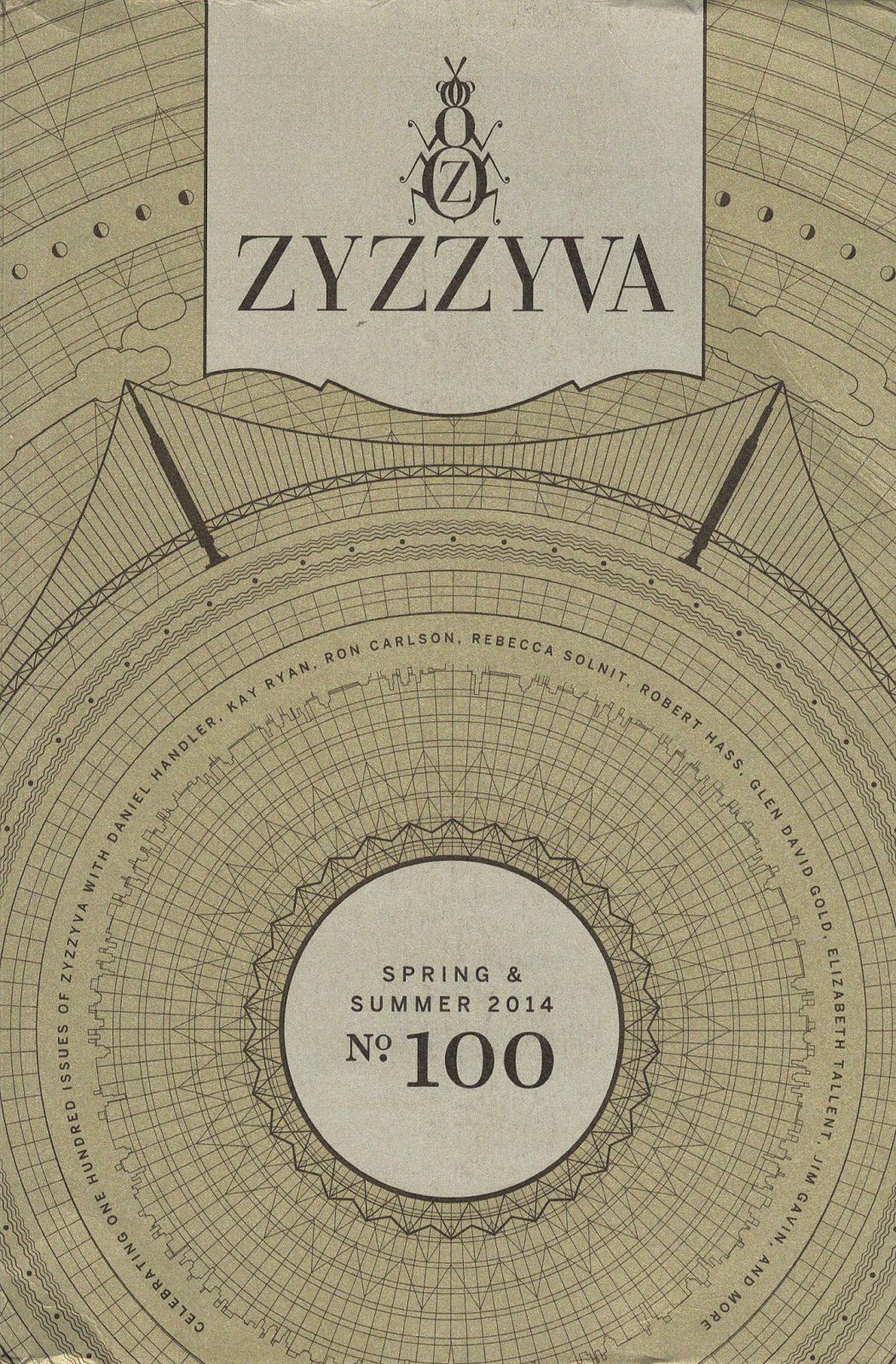
In a time when magazines and newspapers are eschewing paper for online models, there is a publication that insists on print, with a skeleton staff of just two editors. ZYZZYVA, which has just brought out its 100th issue this spring, has not only survived in this tough climate, but thrived as a paper-and-ink literary journal that fosters a community of West Coast writers.
The first contact I had with ZYZZYVA was fittingly old-fashioned, on cream-colored paper delivered by the mailman. Assuming the thin envelope to be just another rejection, I asked my fiancé to toss it in the recycling bin along with the pizza coupons and credit card solicitations. He opened it after I went to bed, and found a letter from editor Laura Cogan asking to print my 9,000-word story—an unsightly hulk that many had warned would be impossible for an unknown like me to publish.
ZYZZYVA isn’t opposed to using technology (turned out, I’d forgotten to include my e-mail with my submission—hence the letter), but there was something decidedly gentle and traditional about the way the two editors approached our relationship. They carefully mulled over every word, and gave me plenty of time to revise and a chance to accept or refuse the changes they made; once the story was published, they became mentors of sorts, going out of their way to nominate me for awards and fellowships.
And my experience with ZYZZYVA isn’t an exception. The journal, founded by Howard Junker, had already been championing San Francisco writers for decades before Junker retired in 2010. Laura, who’d begun as a volunteer reader, took over, bringing in Oscar Villalon, who had run the book review section of the San Francisco Chronicle. Celebrating their landmark edition (100th, and coincidentally the 10th issue of ZYZZYVA that Laura and Oscar have edited together), they chatted with me about what it means to be a print literary publication in San Francisco.
***
The Rumpus: Now that you have the 100th issue out, how do you feel?
Laura Cogan: It’s a terrific milestone for this organization, and I’m so glad to be a part of it. I feel wonderful about the roster of writers we’ve published over the years, and I think the 100th issue is both representative of the journal in general, and a fitting celebration.
Oscar Villalon: It’s nice to see writers stretch out and deliver pieces that you might not have expected. Fiction writers like Jim Gavin, Glen David Gold, Edie Meidav, and Katie Crouch wrote great nonfiction pieces for us.
Cogan: And it’s great to have authors like Elizabeth Tallent, Ron Carlson, and Michelle Latiolais back in the journal…
Villalon: …and two former US poet laureates, Robert Hass and Kay Ryan, who were also past contributors to ZYZZYVA.
Rumpus: But I noticed that there was no First Time in Print section. ZYZZYVA usually makes a point of publishing new writers alongside established ones. Was the omission intentional for the 100th issue?
Cogan: No. We always love having the First Time in Print section. (We highlight the first-time authors in the table of contents as well.) But we simply didn’t find a piece for this issue. In the past we’ve had issues with multiple First Time in Print pieces. In the Winter [2014] issue, for example, we featured two never before published fiction authors—Daniel Tovrov and Monique Wentzel. I suppose we could have saved one of their stories for the 100th issue, but we were excited to run them when we received them.
Villalon: We do have emerging writers, though, in the current issue. Erika Recordon, for instance.
Rumpus: How do you find new writers?
Cogan: Mostly from the unsolicited submissions. We rely on unsolicited manuscripts for about half of all the work we publish.
Rumpus: Could you take us through your selection process?
Cogan: Our interns read the submissions first, then the two of us read every manuscript, too. We receive about 150 manuscripts a month, though this year it has been closer to 170 a month. We can only publish about fifty writers a year, so the odds are tough. The selection process can be very time-intensive for us. It’s important we give each manuscript the time that it deserves; sometimes that means that we need to set something aside, and look at it again the next day with fresh eyes.
Rumpus: What do you look for in a manuscript?
Cogan: What every reader is looking for in a literary experience: to be captivated, to be engaged, surprised and moved. To read something unexpected, and to see something important dealt with on the page. Beyond that, we’re looking for pieces where we can bring our work as editors to bear, and help a manuscript grow from promising to ready.
Rumpus: But how do you differentiate promising from just-not-ready?
Villalon: Basically, it’s a judgment call—how much time is it going to take for me to “fix” this? A reasonable time, for sitting down and figuring out some structural things here, line edits there. And will the results be successful?
Cogan: Or, how much does the author have yet to write? Or is it a matter of bringing out and clarifying what’s already on the page?
Rumpus: Reading every submission is no easy task when there are only two of you on staff. Is the trouble worth it?
Cogan: Absolutely, yes. We are dedicated to taking risks on new and emerging talents, and presenting new writers alongside new works by established talents. Not only is it part of our mission to support emerging writers, but it’s part of what makes the journal interesting, and a place of discovery for readers.
Rumpus: The journal has been around since 1985. What, aside from its dedication to championing emerging talents, do you credit for its success?
Villalon: We don’t have an obvious peg, or a specific school of literature we ascribe to. The journal reflects that, I think. We don’t chase trends, which would involve taking whatever type of writing seems to be selling and offering something similar. We also publish esteemed writers like Herbert Gold, the late Wanda Coleman, Michelle Latiolais and Ron Carlson—those writers who continue to produce tremendous stories and poems. It’s important to keep giving these master craftsmen the space they merit.
Then there’s our being in San Francisco and having been part of the literary community here for so long, which has made ZYZZYVA an outlet and forum for these and other artists.
Rumpus: What’s surprised you the most during your tenure?
Villalon: To be honest, not a lot. I was used to working with limited resources at the Chronicle, where there were only two of us at one point working on the Books section.
Cogan: I knew I would enjoy working with authors and interns, reading and editing manuscripts, but I was surprised by how engaging and creatively fulfilling working on the redesign of the magazine with Josh Korwin has been.
Every day is varied. There are many things that we have to do beyond just the editorial work to keep the place running: all the development, blog posts, answering emails, administrative work, mailing, managing subscribers, merchandizing, IT… Anything you can think of involved in running a journal is done between the two of us, a helping hand from our terrific consultants, and two or three interns.
Villalon: We’re an independent nonprofit, not aligned with any university or foundation, so we have to do as much as we can with what we have.
Rumpus: Does that leave any time for you to read for enjoyment?
Villalon: Absolutely, but for me at least, it means I’m behind everybody else when it comes to reading what’s new. I’m just getting into Rachel Kushner’s The Flamethrowers, which I’m enjoying tremendously, and I’m similarly enjoying an old Le Carre novel, A Perfect Spy.
Cogan: It’s an ongoing struggle to balance work with recreational reading. I’m far too behind on recent books, but always trying to catch up—and at the same time, I’m often dipping back to read older books I’ve always meant to read. So I have Quesadillas by Juan Pablo Villalobos on my shortlist at the moment, as well as Middle C by William H. Gass. And I’d love to read Rachel Kushner’s book soon, too. I’ve just finished The Radetzky March by Joseph Roth, which I’d been meaning to read for years—but which feels timely, even now. I’m also very much looking forward to reading In Paradise by the incomparable Peter Mathiessen, whose death [earlier this month] is a major loss. I’d urge anyone who has not yet had the pleasure of discovering his work to pick up Shadow Country, which is truly a masterpiece.
Rumpus: Does longform storytelling have a place in a society that’s increasingly more accustomed to 140 characters?
Villalon: Definitely. 140 characters is just not enough for all that needs to be said. It’s as simple as that.
Cogan: Immersive experience is part of the reason. I think some readers want to experience the pleasure to be taken out of their hectic lives for an extended time, whether in digital or print formats. The pleasure of a story unfolding over time, of twists and turns in the plot, of character development over time: these are some of the pleasures of reading that many of us discovered as children, and which are still powerful today. That hasn’t changed, and can’t be replicated in 140 characters.
Rumpus: Still, longform or not, print is constantly struggling. Can you imagine going web-only?
Cogan: No. Even though digital and print will and should coexist, I believe our audience is happy to have a print publication.
Villalon: Print has a physical presence, if you will. You see the stack of books on your night table or desk or on your living room floor, and you are aware of them. It’s hard to forget they’re there, waiting to be read or re-read. In digital form, on a device, these books are easier to overlook, I think. It’s a problem of “out of sight, out of mind.” (That’s the problem I have with digital music stored on my phone. I keep forgetting what songs I have because I can’t readily “see” them, like I can when looking at a stack of CDs or box sets.)
Cogan: I still think that print seems to be the ideal way to read literature, that we’ve yet to find a superior technology. And I personally find that the depth of concentration and focus I have when reading in print is distinct from the way my mind works when reading on a screen. As for ZYZZYVA, we are dedicated to print, and the sensory pleasures of a beautifully-designed and well-bound book are a part of what the journal offers. That said, we’re certainly not opposed to developing a digital subscription model as well—and we may do so in the future.
Rumpus: So what else is in store for ZYZZYVA’s future?
Villalon: We’ll keep maintaining, if not growing, as a San Francisco literary journal. As you know, these are tough times for anybody in the arts: it’s hard to find office space, hard to live in the city, etc. But we believe we can still thrive here despite all of that. It would be a shame to have such an important cultural institution disappear, and I think there are many more people than just Laura and me who think that.
Cogan: We are always searching for ways to show our subscribers that they’re not just signing up to buy issues of the journal: by subscribing, they are supporting a vibrant public life around contemporary art and literature. It’s a challenging time for any literary enterprise and any print publication. It’s now especially important to engage with the community, and be innovative about creating a literary community. We try to run a robust and varied schedule of events each year, and to collaborate with other arts organizations.
It’s a tremendous responsibility to steward this journal that was already so accomplished when Oscar and I came in; and it’s heartening to see that the community continues to embrace it.
***
Together with City Lights Bookstore, ZYZZYVA will celebrate its 100th issue with a gala on May 8th at the California Historic Society. The evening’s presenters and performers including Michael Krasny, Daniel Handler, Erika Recordon, Po Bronson, Robert Hass, and more.






